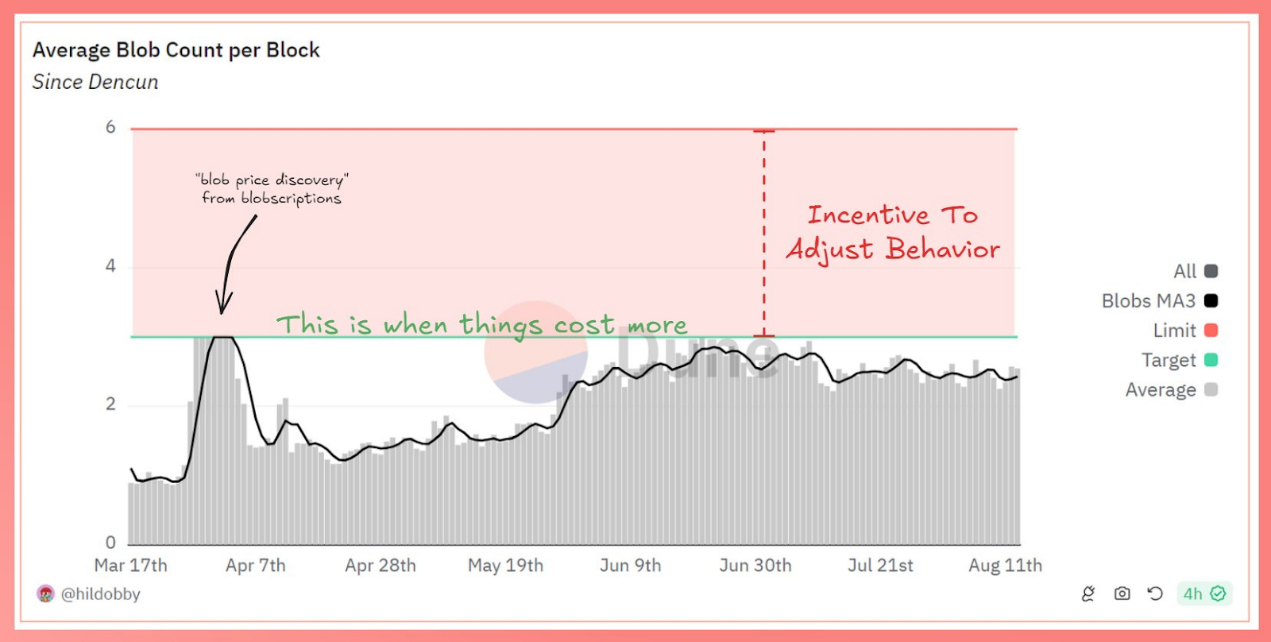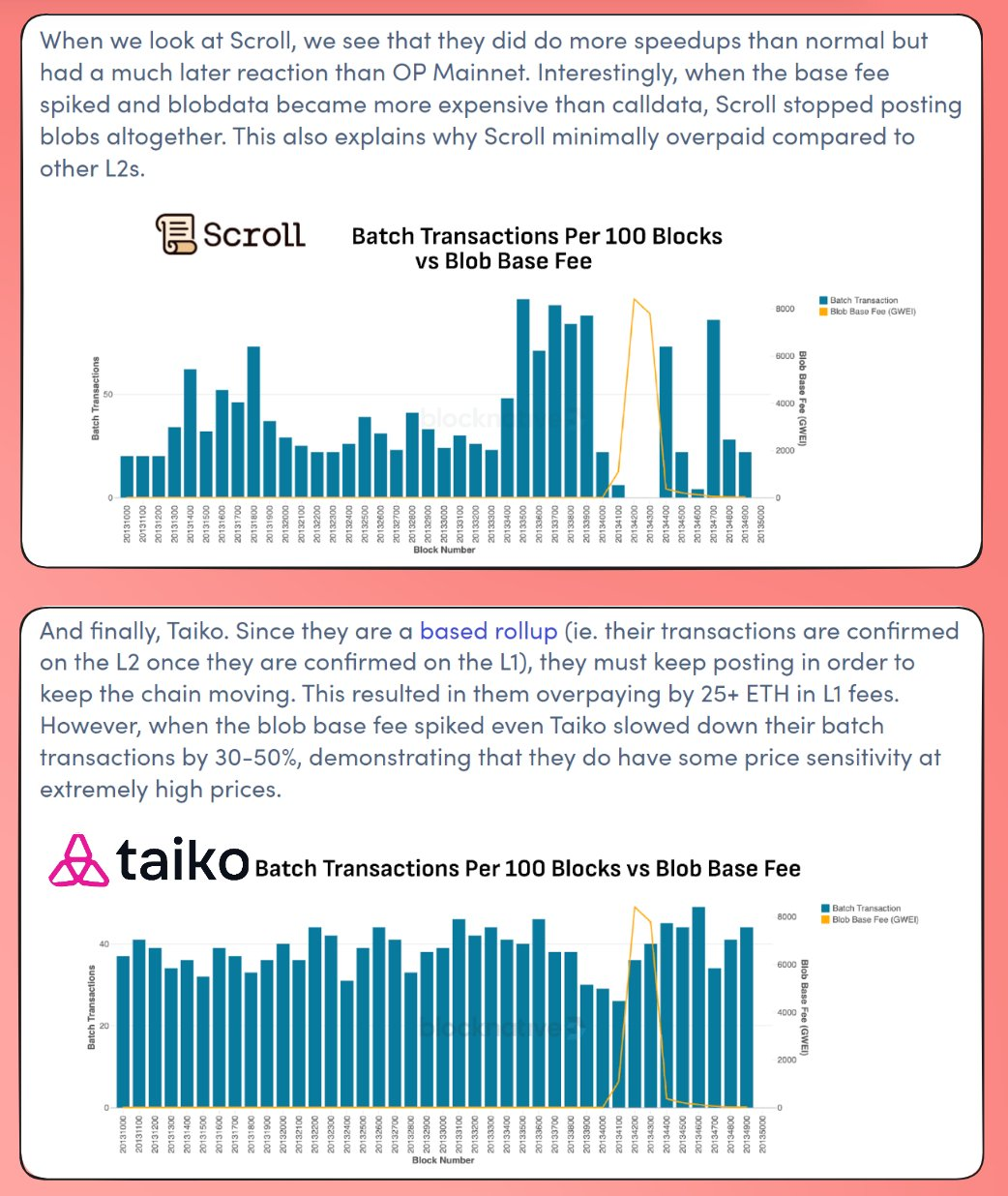원저자: BREAD , 암호화 KOL
원문: 펠릭스, PANews
There is a view circulating in the crypto community that L2s will cause Ethereum to fall into deflation again. This statement is incorrect, and there are already examples to prove it.
This is a report on L2, blobs, and why the Ultrasound Money meme will die without mainnet users.
(Note: A meme related to Ethereum that is used to highlight its potential to become deflationary in the long term. The basic concept is that if the supply of gold or Bitcoin is capped and is considered Sound Money, then the supply of Ethereum is decreasing and should be considered Ultrasound Money)
키 포인트:
-
L2s will only deflate ETH if both blob and regular fee markets are saturated
-
L2 is largely unconstrained by the specific batch release cadence of L1
-
The combination of the above means that L2s will constantly coordinate with each other to avoid creating a high-fee environment for themselves
배경
First a brief recap of where Ethereum stands after Dencun (the March upgrade that made L2s ~10x cheaper for users).
Dencun introduces the concept of blob space, an extension of block space on Ethereum designed to allow L2 to publish its batch data.
This new area has several noteworthy features:
-
Blobspace is currently limited to 6 individual blobs per block
-
This is a separate fee market from the regular blockspace, but uses similar mechanisms
Blockspace : If the utilization of the current block is > 50%, increase the base fee of the next block
Blobspace : Increase the base fee of the next block by approximately 12% if there are 4 (i.e. >50%) or more blobs in the current block
Note: L2s can decide whether to use Blockspace or Blobspace.
Given the above, it is possible to predict some of the expected behavior flows of these L2s that will lead to a destruction:
-
L2s will first saturate the blobspace until it is no longer free (3 blobs/block)
-
Once they reach this level, they will start calculating the release cost/reputation savings and choose between:
-
a.) Using calldata
-
b.) Reduce the frequency of releases/decentralize/coordinate to cool down the fee market
That said, while the top L2s are already making millions in profits each month (with profit margins approaching 100%), L2s will continually adjust their behavior to avoid creating a high-fee environment for themselves.
ETH Vampire Death Loop:
-
Extending the low-cost environment
-
Waiting for Ethereum to expand and reset the market
-
Extending the low-cost environment
-
Waiting for Ethereum to expand and reset the market…
So when does ETH plan to expand?
This could expand blob capacity by about 2-3 times as early as next year with the Pectra update.
The market does not provide many such opportunities, but there are two examples where L2s intentionally modified their behavior to save costs and avoid fees (as any business or rational actor would do).
Example 1: The Blobscriptions craze
In late March, blobs underwent “price discovery” during the blobscription phase, though: L2s and builders capped their blobs at a non-price-increasing level of 3 blobs/block on average:
데이터 출처: Dune
They had no obligation to exceed fee increases, so they didnt.
Example 2: LayerZero 공중 투하
On June 20, the ZRO airdrop caused a significant increase in trading volume on Arbitrum and led to an influx of it into the blob market.
in short:
-
More blobs from ARB
-
All L2s have higher blobs cost
-
L2 destroyed ~$800k in ETH due to lack of proper infrastructure to switch to regular blockspace
If you want to know more, you can check out the author’s other 짹짹 .
The biggest takeaway from this event is how teams are responding to the high-fee environment:
Scroll is a zk rollup with no publishing obligation, and has completely stopped publishing.
When looking at Scroll, they did indeed post faster than normal, but reacted much later than OP Mainnet. Interestingly, when basefees spiked and blobdata became more expensive than calldata, Scroll stopped issuing blobs altogether. This also explains why Scroll has the least fees compared to other L2s.
Taiko is a rollup with a strict rhythm that slows down batch processing.
Since Taiko is Rollup-based (i.e. once their transactions are confirmed on L1, they are confirmed on L2), they have to constantly post information to keep the chain moving. This caused them to pay 25+ ETH more in fees on L1. However, when the blob base fee spiked, even Taiko slowed down batching by 30-50%, indicating that they do have some price sensitivity at extremely high prices.
Both market participants have taken reasonable steps to reduce their overhead costs.
In the future, they will definitely adopt automated processes to avoid wasting hundreds of thousands of dollars before the conversion.
All L2s will.
What can be done?
When I set out to write this report, I simply calculated that “4 more base-level L2s would be needed to generate ETH Ultrasound Money™️ again”, but the more I dug, the more I realized that this goal would never be achieved.
L2 will constantly adjust its behavior to avoid high costs. They are businesses, of course they will do this.
So given the above, what should be done? Make the mainnet cool again and attract users and builders.
A balance must be struck between scaling via L2s and keeping power users on the mainnet, rather than pushing them indiscriminately into one of a dozen differently structured ecosystems that provide minimal economic returns to Ethereum.
Make progress by adjusting your messaging:
-
Fill capacity
-
Expand to appropriate level
-
Tell users and applications to go away (skip this step)
-
Scaling via L2s
Measures like EIP-7623 could also be implemented to prevent L1 user block space from being used as L2 cost-saving failover space.
Relying on L2s as participants and the mainnet as pure settlement, isnt it? With the current incentives, this is not the case.
This article is sourced from the internet: Why L2 Won’t Make Ethereum Deflationary?
관련 기사: 솔라나가 ZK 압축을 출시했는데, 이더리움 커뮤니티가 붕괴되었을까?
Solana와 Ethereum 커뮤니티가 다시 논쟁을 벌이고 있습니다. 이번에는 Solana의 새로 출시된 ZK 압축 기술을 두고 말입니다. 어제 Solana 생태계 개발 플랫폼 Helius의 CEO인 Mert Mumtaz는 X 플랫폼에서 ZK 압축이 Solana에 도입된다고 발표했습니다. 얼마 지나지 않아 Solana 생태계 프라이버시 프로젝트 Light Protocol이 ZK 압축을 출시한다고 발표했습니다. Mert에 따르면 ZK 압축은 L2 없이 L1에서 직접 수행되어 Solana 네트워크의 확장성을 크게 개선하고 빛의 속도로 동기화되는 멈출 수 없는 글로벌 원자 상태 머신인 금융 컴퓨터를 구축하는 데 한 걸음 더 다가갈 것입니다. ZK 압축 설명서에 따르면 이 기술은 Solana에 기반한 새로운 기본 기술로, 개발자가 대규모로 애플리케이션을 구축할 수 있도록 합니다. 개발자와 사용자는 압축을 선택할 수 있습니다…










